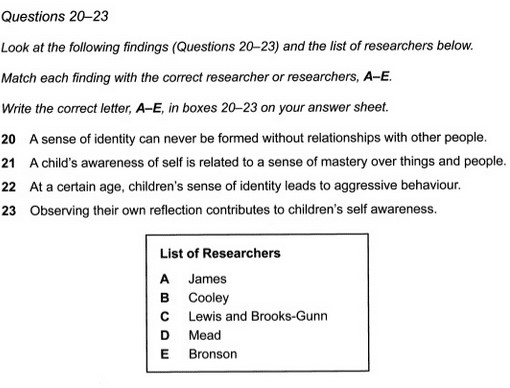Matching Features thuộc một dạng trong Matching nhưng bạn chớ nhầm lẫn mà cần chú ý kỹ để áp dụng các bước làm bài hiệu quả nha.
1. Matching Features là gì?
Nhiều bạn nhầm lẫn giữa các dạng Matching. Matching Headings là tìm nội dung chính và nối với tiêu đề của đoạn văn. Matching Information là tìm thông tin có trong bài đọc và nối với đoạn văn tương ứng. Và đây là Matching Features, là nối thông tin trong bài đọc với Features tương ứng, “Features” ở đây có thể là “tên riêng, địa danh, các loại hình, năm tháng…” nhưng đa phần mình thấy là “tên” là chủ yếu. Có thể là tên các nhà khoa học, tên nhân vật được nhắc đến trong bài, tên các bộ phận cơ thể (các phần của não bộ), tên các loại hình tư duy, các bài nghiên cứu…
Cách làm dạng bài này khá đơn giản nhưng cũng rất dễ sai vì bài đọc sẽ đánh lừa và nhiễu thông tin rất nhiều. Nên phải dựa vào sự đọc – hiểu và nhạy bén, không cảm tính, không tự suy luận và đặc biệt là hoàn toàn dựa vào THÔNG TIN CUNG CẤP trong bài đọc.
Cách làm bài mình sẽ nói bên dưới, các bạn nhìn sơ qua dạng bài nhé!

Minh hoạ dạng bài Matching Features
2. Cách làm bài Matching Features
Bước 1: Gạch chân keywords trong câu hỏi + Khoanh tròn Features
Việc đầu tiên chúng ta cần làm đó là gạch chân những keywords trong đề bài, chưa đọc bài đọc nhé! Vì dạng Matching Feature này chúng ta đã có sẵn tất cả các thông tin nên mình khuyên phần gạch chân Keywords này nên được diễn ra nhanh chóng để tiến hành Scanning tên riêng + Đọc bài đọc. Ví dụ
1. Giving up short-term happiness for future gains
-> Chú ý: give up, short-term happy, for future
2. Maintaining the bodily functions necessary for life
-> Chú ý: maintain, bodily functions, necessary
Bước 2: Scanning Feature trong bài đọc
Các bạn đọc thật kỹ các Feature xem nó là list của cái gì. Ví dụ list tên các nhà khoa học, list tên riêng, list tên các trường đại học, list các tên riêng khoa học chỉ cơ thể người…
Sau khi đã nắm được rồi, hãy làm song song với các dạng bài khác luôn! (Hầu như dạng Matching nào cũng làm song song được nhỉ). Trong quá trình đọc bài đọc thấy có tên riêng nào trong list ở trên thì khoanh tròn/ đóng khung lại sao cho nổi bật. Rồi đọc những câu xung quanh đó, nếu match thông tin nào thì chọn câu trả lời luôn!
Nghe đơn giản vậy thôi nhưng chắc chắn 100% sẽ có những thông tin nhiễu làm chúng ta phải phân vân, hoặc đọc mãi nhưng không hiểu nó thuộc về Feature nào. Lúc đó hãy tick lại 1 dấu rồi chuyển sang câu tiếp theo.
Thông thường sẽ có một số điểm các bạn cần lưu ý:
Ví dụ List đó là list tên riêng các tác giả văn học đi nhé. Thì tên riêng của ông X đã xuất hiện trong đoạn B. Thì không chỉ tới đó là hết. Mà bạn còn phải đọc hết bài, tức là tên ông X sẽ còn xuất hiện nữa trong đoạn G, H… nữa cơ. Mà đôi khi không phải khoanh tròn tên riêng là xong đâu nha. Vì bài đọc hoàn toàn có thể cho những từ tương đương để chỉ ông X, ví dụ “he”, “he says”, “this author”,…. Nên bạn phải đọc thật kỹ!
Bước 3: Check đáp án
Bước này thì các bạn check lại những câu mình còn phân vân thôi. Và dùng phương pháp loại trừ nữa. Nếu thấy 1 Feature nào được sử dụng quá nhiều, ví dụ như đề bài có 7 câu hỏi, mà feature đó xuất hiện 5, 6 lần thì may be khả năng cao là sai ở đâu rồi đó!
Nói chung phần này mình thường đọc lại hết để check lại đáp án chắc chắn đúng, vì đây là dạng Matching không quá khó nên mình không muốn bị mất điểm phần này. Hầu hết các bạn sai là do đọc lướt, đọc ẩu, không kỹ…, chứ dạng này mình thấy không có trick, lừa lọc quá nhiều… nên cố gắng hết sức đừng để bị sai nhé!
3. Luyện tập
The Triune Brain
The first of our three brains to evolve is what scientists call the reptilian cortex. This brain sustains the elementary activities of animal survival such as respiration, adequate rest and a beating heart. We are not required to consciously “think” about these activities. The reptilian cortex also houses the “startle centre”, a mechanism that facilitates swift reactions to unexpected occurrences in our surroundings. That panicked lurch you experience when a door slams shut somewhere in the house, or the heightened awareness you feel when a twig cracks in a nearby bush while out on an evening stroll are both examples of the reptilian cortex at work. When it comes to our interaction with others, the reptilian brain offers up only the most basic impulses: aggression, mating, and territorial defence. There is no great difference, in this sense, between a crocodile defending its spot along the river and a turf war between two urban gangs.
Although the lizard may stake a claim to its habitat, it exerts total indifference toward the well-being of its young. Listen to the anguished squeal of a dolphin separated from its pod or witness the sight of elephants mourning their dead, however, and it is clear that a new development is at play. Scientists have identified this as the limbic cortex. Unique to mammals, the limbic cortex impels creatures to nurture their offspring by delivering feelings of tenderness and warmth to the parent when children are nearby. These same sensations also cause mammals to develop various types of social relations and kinship networks. When we are with others of “our kind” – be it at soccer practice, church, school or a nightclub – we experience positive sensations of togetherness, solidarity and comfort. If we spend too long away from these networks, then loneliness sets in and encourages us to seek companionship.
Only human capabilities extend far beyond the scope of these two cortexes. Humans eat, sleep and play, but we also speak, plot, rationalise and debate finer points of morality. Our unique abilities are the result of an expansive third brain – the neocortex – which engages with logic, reason and ideas. The power of the neocortex comes from its ability to think beyond the present, concrete moment. While other mammals are mainly restricted to impulsive actions (although some, such as apes, can learn and remember simple lessons), humans can think about the “big picture”. We can string together simple lessons (for example, an apple drops downwards from a tree; hurting others causes unhappiness) to develop complex theories of physical or social phenomena (such as the laws of gravity and a concern for human rights).
The neocortex is also responsible for the process by which we decide on and commit to particular courses of action. Strung together over time, these choices can accumulate into feats of progress unknown to other animals. Anticipating a better grade on the following morning’s exam, a student can ignore the limbic urge to socialise and go to sleep early instead. Over three years, this ongoing sacrifice translates into a first class degree and a scholarship to graduate school; over a lifetime, it can mean ground-breaking contributions to human knowledge and development. The ability to sacrifice our drive for immediate satisfaction in order to benefit later is a product of the neocortex.
Understanding the triune brain can help us appreciate the different natures of brain damage and psychological disorders. The most devastating form of brain damage, for example, is a condition in which someone is understood to be brain dead. In this state a person appears merely unconscious – sleeping, perhaps – but this is illusory. Here, the reptilian brain is functioning on autopilot despite the permanent loss of other cortexes.
Disturbances to the limbic cortex are registered in a different manner. Pups with limbic damage can move around and feed themselves well enough but do not register the presence of their littermates. Scientists have observed how, after a limbic lobotomy , “one impaired monkey stepped on his outraged peers as if treading on a log or a rock”. In our own species, limbic damage is closely related to sociopathic behaviour. Sociopaths in possession of fully-functioning neocortexes are often shrewd and emotionally intelligent people but lack any ability to relate to, empathise with or express concern for others.
One of the neurological wonders of history occurred when a railway worker named Phineas Gage survived an incident during which a metal rod skewered his skull, taking a considerable amount of his neocortex with it. Though Gage continued to live and work as before, his fellow employees observed a shift in the equilibrium of his personality. Gage’s animal propensities were now sharply pronounced while his intellectual abilities suffered; garrulous or obscene jokes replaced his once quick wit. New findings suggest, however, that Gage managed to soften these abrupt changes over time and rediscover an appropriate social manner. This would indicate that reparative therapy has the potential to help patients with advanced brain trauma to gain an improved quality of life.
Nguồn: The British Council 2012.
Questions 14–22
Classify the following as typical of
A The reptilian cortex
B The limbic cortex
C The neocortex
Write the correct letter, A, B or C, in boxes 14–22 on your answer sheet.
14 Giving up short-term happiness for future gains
15 Maintaining the bodily functions necessary for life
16 Experiencing the pain of losing another
17 Forming communities and social groups
18 Making a decision and carrying it out
19 Guarding areas of land
20 Developing explanations for things
21 Looking after one’s young
22 Responding quickly to sudden movement and noise
KEY ANSWER
14 C
15 A
16 B
17 B
18 C
19 A
20 C
21 B
22 A
Link tải bản PDF nhé:
| Reading Matching Features |
Xem thêm bài học cùng lộ trình:
Sharpen your IELTS Reading Skill - SHORT ANSWER
Sharpen your IELTS Reading Skill - MATCHING INFORMATION





